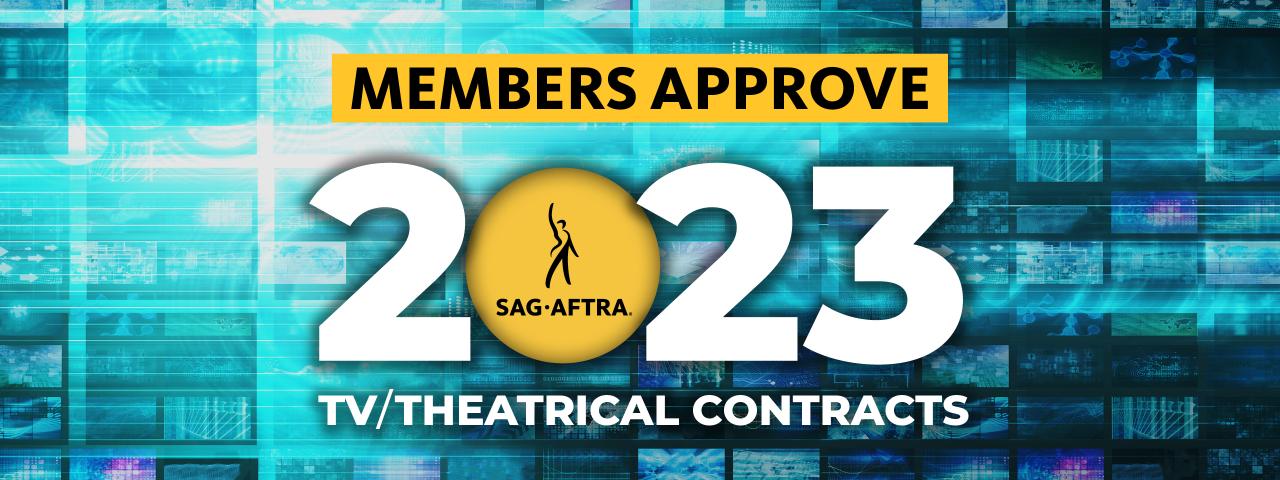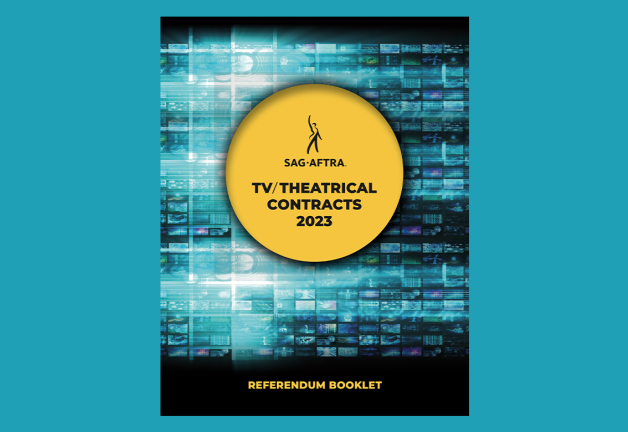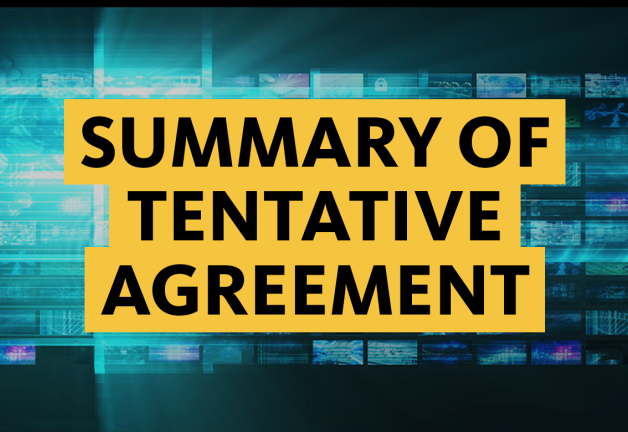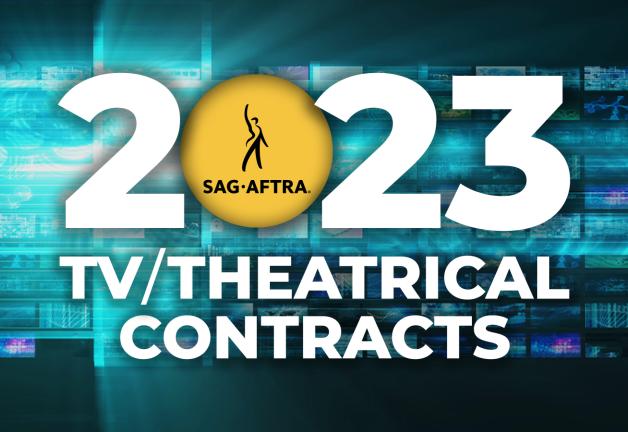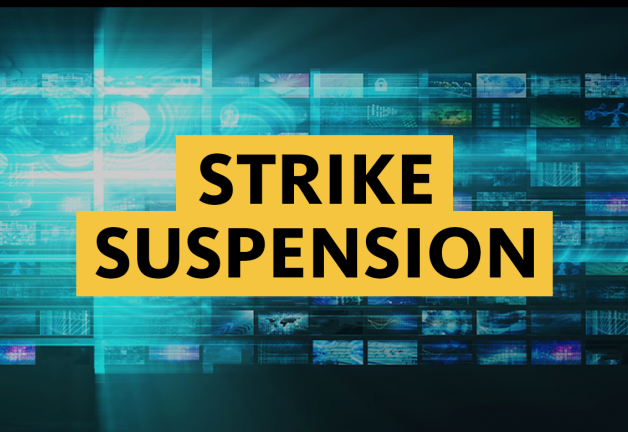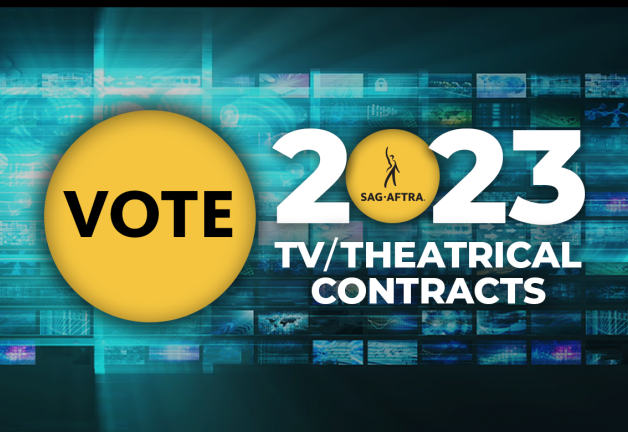In national voting completed Tuesday, Dec. 5, members of SAG-AFTRA ratified the 2023 TV/Theatrical Agreement with the Alliance of Motion Picture and Television Producers (AMPTP). Members approved the new, multi-year contracts covering television, theatrical and streaming production by a vote of 78.33% to 21.67% with a turnout of 38.15%.
SAG-AFTRA National Board Approves Tentative Agreement, Recommends Ratification of 2023 TV/Theatrical Contract
Nov. 10, 2023
The SAG-AFTRA National Board met today in a video conference plenary and approved the tentative agreement for the 2023 TV/Theatrical Contracts reached with the Alliance of Motion Picture and Television Producers (AMPTP) on November 8, 2023. With the board’s approval, the deal now goes to the union’s membership for ratification. The board approved the tentative agreement by a majority of 86% to 14% and recommended a vote of “yes” to ratify the contracts. “I was determined to redefine SAG-AFTRA as not only the largest entertainment union in the world, but the most powerful. And now that we have forged the biggest deal in industry history which broke pattern, established new revenue streams and passed a historic $1 billion plus dollar deal with the most progressive AI protections ever written, I feel pretty confident in saying this is a paradigm shift of seismic proportions! I am so proud of the TV/Theatrical Negotiating Committee and so thrilled to have partnered with Duncan Crabtree-Ireland” said SAG-AFTRA President Fran Drescher. “Onward and upwards!”
FAQs
-
- We will post details of the tentative agreement at sagaftra.org/contracts2023 and will hold informational meetings both in-person and virtually. The details for those meetings will be posted at sagaftra.org/contracts2023 as soon as they are finalized.
-
- The new TV/Theatrical Agreement is subject to the review and approval of the National Board. Once the National Board has done so, the Agreement is subject to a ratification vote by the union’s membership. The contract does not become valid until a majority (50%+1) of voting members votes “YES” to approve it. 2023.
-
- Yes, this contract covers scripted dramatic productions that are made for streaming platforms, in addition to the distribution of dramatic productions on streaming services that were originally made for other platforms.
-
- If the union fails to ratify the new agreement, the terms of the previously-terminated 2020 TV/Theatrical Contracts would still apply to performers working under those contracts with two exceptions. First, any producer that signed an Interim Agreement in 2023 would be required to abide by the terms of that Interim Agreement. Second, certain key provisions of the 2020 TV/Theatrical Contracts do not apply following the termination of those agreements, including most importantly the arbitration language. That means that the union is unable to arbitrate claims under those agreements that accrued post-termination, unless a separate agreement is in place with the producers permitting arbitration.
-
- If the union fails to ratify the new agreement, the National Board and TV/Theatrical Negotiating Committee will have to meet to decide the next steps, including potentially approaching the AMPTP about additional negotiations. However, while the AMPTP has an obligation to bargain with the union, a "no” vote from the members does not force the AMPTP to do so, or to do so within a specific time period, and it's possible (and likely) that additional negotiations would not take place immediately.
-
- The prior strike authorization remains in place, and the prior strike was only suspended, not terminated. Therefore the negotiating committee has the power to resume the strike if they feel this is the most strategically advantageous move.
-
- Yes, it is possible. If the union fails to ratify the agreement, it is possible and potentially likely that the AMPTP may revoke some or all of the moves it made and concessions it offered, in the current tentative agreement.
-
- Following a unanimous vote of the TV/Theatrical Negotiating Committee on November 8, 2023, the strike is suspended as of 12:01 a.m. on November 9, 2023. Following this time, all orders and rules set forth in SAG-AFTRA’s July 13, 2023 Strike Notice and Order are suspended pending consideration of the tentative TV/Theatrical Agreement by the National Board and membership. All members are instructed to fulfill their contractual obligations and return to work, including services related to publicity and the promotion of motion pictures produced under the TV/Theatrical Agreements, without consequence or conflict with the union.
-
- No. If you are called back to work, you should return. If you are concerned that a producer is asking you to return to work under improper conditions, please reach out to Entertainment Contracts at entcontractsinfo@sagaftra.org.
-
- Reach out to Entertainment Contracts at entcontractsinfo@sagaftra.org if you believe you are being retaliated against as a result of your union membership or participation in the strike.
-
- Members may immediately resume full participation in conventions and personal appearance events, including panel discussions, autograph signings, and in-character appearances. We appreciate and applaud your ability to navigate the convention guidelines in front of crowds of fans who were eager to discuss your work.
-
- First, thank you for your solidarity throughout the strike. Your support of striking performers and your commitment to not promote struck work this summer was inspiring and enormously impactful. You played a crucial part in the successful resolution of this strike that will not be forgotten.
- Now that the strike is over, social media influencers may immediately resume publicity and promotional activities without consequence or conflict with the union. Any creators who are not yet members of SAG-AFTRA are welcome to seek eligibility through our Influencer Agreement and Waiver. This union is here for you, too. If you have questions, don’t hesitate to get in touch at influencer@sagaftra.org.
-
- We’re so appreciative of your solidarity and support throughout this strike. We recognize the sacrifices many podcasters made to stand with us in our effort to achieve a fair contract. Podcasters may immediately resume discussion and promotion of film and television, including interviews with SAG-AFTRA members regarding their projects. If you would like information about our SAG-AFTRA Podcast Agreements, or have any other podcast questions, don’t hesitate to reach out to podcastcontracts@sagaftra.org. Podcast hosts and performers are media professionals and deserve the benefits of a union contract, too!
-
- Non-members may immediately return to performing covered services for previously-struck producers and continue working towards union membership. For details of the eligibility requirements for SAG-AFTRA membership and steps to join, please click HERE.
- _
- _
-
- Following a unanimous vote of the TV/Theatrical Negotiating Committee on November 8, 2023, the strike was suspended as of 12:01 a.m. on November 9, 2023. Your clients should immediately fulfill their contractual obligations and return to work, including services related to publicity and the promotion of motion pictures produced under the TV/Theatrical Agreements, without consequence or conflict with the union. More details surrounding the immediate return to work will be available following the National Board meeting scheduled for Friday, November 10.
- _
- _
-
- The terms of your interim agreement will prospectively conform to the new TV/Theatrical Agreement upon ratification. Your signatory business representative will be in touch with any further steps.
-
- Productions signed to interim agreements can be sold to and distributed by AMPTP companies. If the new TV/Theatrical Agreement is ratified, the terms of that Agreement will apply moving forward, including the application of the new residuals terms to that distribution.
-
- With 160,000 members, SAG-AFTRA is larger than many small countries! Together, we’ve become the focal point of a global labor movement, and the mobilization of our members — whether in person or on social media — has kept important issues around worker empowerment and corporate greedflation in the forefront of public discourse. Let’s keep this momentum going and be a force for much-needed change both within our industry and for workers’ rights everywhere!
- 1. In the coming months, IATSE, Teamsters Local 399, and AFM will be negotiating their new contracts. Let’s make sure we rally for them just as much as we’ve rallied for ourselves. Follow the entertainment industry labor unions on social media, share their posts, and create your own unique messages of support.
- 2. While SAG-AFTRA’s new contract has protections around AI, legislators still need to make AI protections and intellectual property enforcement a matter of public policy. Support SAG-AFTRA’s legislative efforts and follow the Human Artistry Campaign to be a part of the movement to protect individuals’ rights to their likeness.
- 3. Make sure you are always working under a SAG-AFTRA contract when you are in front of a camera or behind a microphone. It’s the most important way you can stand in solidarity with your fellow members every day.
- We have skills. Let’s use them!
- Performers have an exceptional ability to use charisma as a tool to draw attention to a cause. The more we empower our labor siblings and push for more public policy protections around AI, the better position we’ll all be in to create a more equitable entertainment industry. The employers may have the money, but we have the numbers and they can’t do anything without us!
-
- Notice obligations under Section 43 of the TVA are waived for performers who are called back to work prior to January 31, 2024.
-
- For performers who commence principal photography services for a following season prior to January 31, 2024 on shows that completed principal photography for the season on or after May 1, 2023, the requirement for a conflict-free window (or penalty fee) is waived.
-
- Option periods and exercise dates are deemed automatically suspended during the strike period and automatically extended for a like period of time.
-
- Yes, you may resume promotion of previously completed projects.
-
- Yes. As always, remember that you should not travel, rehearse, or otherwise work on a project before confirming it is cleared to start via the member app, the signatory search on sagaftra.org, or by calling the union.
-
- Once the SAG-AFTRA strike ends, the Collective Bargaining Agreement (CBA) provides that the producer may require the performer to report and perform services at the same terms as conditions as were agreed upon prior to the strike. If requested by the producer, the performer must also execute a new contract reflecting the previously agreed-upon terms that is equivalent to the unexpired term of the contract that was in effect as of July 14, 2023, or execute an extension agreement extending the term of the contract for a period of time equal to the suspension due to the strike (July 14, 2023, to November 9, 2023). In some cases, the producer may not require a performer to return or may reduce the episodic guarantee.
- This provision includes extension of any option periods for series regulars in the same manner described above.
- If you do not hear from the producer about resuming your contract, you should find out whether they intend to terminate the agreement. We can assist you in those discussions. Please contact entcontractsinfo@sagaftra.org.
-
- When the union ratifies the new TV/Theatrical Agreement, the terms of the Interim Agreement will merge with the new TV/Theatrical Agreement, and the terms of the new TV/Theatrical Agreement will become applicable to SAG-AFTRA members’ employment on the production, even if the producer signed an Interim Agreement. This process will not affect compensation that SAG-AFTRA members earned and received, or any contributions that had been made on their behalf to the SAG-AFTRA Health and Pension/Retirement plans, while they are employed under an Interim Agreement, before a new TV/Theatrical Agreement is ratified. Any compensation, terms or provisions of the Interim Agreement that have not been earned or utilized by the time the new TV/Theatrical Agreement is ratified, such as residuals applicable to future distribution or compensation for days not yet worked, will change to the terms and rates of the new TV/Theatrical Agreement.
-
- If you were engaged on a production prior to the strike, we encourage your representatives to contact those productions to inquire if they will still be requiring your services. The producers have 45 days from November 9, 2023 to inform you of their decision, but it never hurts to ask if they’ve decided sooner.
-
- Use your voice to encourage other eligible SAG-AFTRA members to vote! We will post a social media toolkit for your use, along with updates, FAQs and more at sagaftra.org/contracts2023. Additionally, keep an eye out for phone banking opportunities – a great way to build camaraderie – in several locals.
-
- Where a producer permissibly reduces a performer’s guarantee pursuant to this Agreement, the producer may require the performer to execute a new contract or amend the existing one to reflect the reduced guarantee at the same episodic fee as was provided in the contract prior to the strike.
- Notice (45 days): The producer must inform the performer by December 24, 2023 if any of the foregoing applies and, if the guarantee is reduced, the producer shall also specify the new guarantee at that time.
-
- For anyone employed on a season of a show prior to the strike and who will resume work on that season after the strike, the period beginning July 14, 2023 and ending on the date the performer returns to work (but in no event later than Jan. 31, 2024) shall be excluded from the calculation of span, work time, consecutive days of employment, and drop and pick-up obligations.
-
- You are being asked to vote on the 2023 TV/Theatrical Agreement, which details terms of employment for SAG-AFTRA members who work under this contract through June 30, 2026. This agreement includes wage minimums, benefit plan contributions, working condition requirements and other studio and streamer obligations.
-
- This new contract achieves the much-needed gains your union has been working toward all year. SAG-AFTRA members made it clear that we needed a game-changing contract and AI protections. This contract does just that. This is why the union is urging you to vote ‘Yes’ so you can lock in the over $1 billion in new compensation and benefit plan funding.
- This agreement also creates a precedent that the AMPTP has agreed to AI protections. If ratified, other unions can model our contract language in their future negotiations.
-
- Under the Strike Suspension Agreement, the SAG-AFTRA and the AMPTP have agreed to jointly recommend to the SAG-AFTRA Health Plan Trustees that participants who would otherwise lose eligibility immediately following an earnings cycle that included all or a portion of the strike period (i.e., an earnings cycle that ended or will end on September 30, 2023, December 31, 2023, March 31, 2024, June 30, 2024, or September 30, 2024) be provided with an additional three months of coverage at the end of such earnings cycle as follows:
- A. Active participants that have an amount of earnings or days during the eligibility period equal to the proportion of the eligibility period between May 2, 2023 and the suspension date of the strike to the duration of the eligibility period multiplied by the applicable eligibility requirement (earnings or days) will receive an additional quarter of coverage and have a one quarter extension of their earnings cycle; or
- B. Active retirees that have an amount of earnings or days during the eligibility period equal to the proportion of the eligibility period between May 2, 2023 and the suspension date of the strike to the duration of the eligibility period multiplied by the applicable eligibility requirement (earnings or days) will receive an additional four quarters of coverage
- Extended Career COBRA benefit extension: Union and AMPTP also will jointly recommend to the SAG-AFTRA Health Plan Trustees that the Extended Career COBRA benefit be extended for three months for participants who exhausted or will exhaust their Extended Career COBRA eligibility as of Sept. 30, 2023, Dec. 31, 2023, March 31, 2024, June 30, 2024, or Sept. 30, 2024.
- The foregoing provisions will take effect upon adoption by the Board of Trustees of the SAG-AFTRA Health Plan.
- More details available in the Strike Suspension Agreement
-
- This agreement includes an unprecedented background actor wage pattern, with two wage increases in the first year of the contract -- 11% effective November 9, 2023 and another 4% increase effective July 1, 2024 for a compounded first year wage increase of 15.51%. Plus another 3.5% increase effective July 1, 2025.
- It also finally increases the number of covered positions for background actors in the West Coast Zones to equal those of the East Coast Zones – a first! This is projected to create 10,700 additional days of covered background work annually.
-
- Dancers made a large gain with rehearsal pay now at the same rate as the shoot day! The new contract allows doubling pay of +25% of the applicable rate for dancers who sing/lip sync and singers who dance. Singers vocal contractor’s will now receive their percentage on top of multi-tracking and/or sweetening.
- Singers who are required to dance whether in rehearsal or on camera receive +25% of the applicable dancer rate.
-
- In addition to the general wage increases, residuals, increases to the contribution limits and other gains that are applicable to all principal performers, including our stunt performers, Stunt Coordinators who do not perform on camera stunts will, for the first time, now receive some fixed residuals for Television (and productions with TV terms and conditions, such as High Budget SVOD series) based on a day player minimum. Also, Stunt Coordinators engaged under a Flat Deal Contract in Television (and productions with TV terms) will have outsized increases of 10%, 6.5% & 5% to their minimum wages.
-
- The contract achieved important gains regarding the sharing of aggregate diversity statistics, further combating inappropriate “wiggings” and “paintdowns,” promoting gender-neutral language, access to gender-affirming care and translation services. These include:
- A commitment to work with other industry partners to expand and maintain the pool of qualified hair and makeup professionals to work with all varieties of hair types and skin tones.
- Opportunities for principal performers to have meaningful consultations regarding any hair and makeup needs so that production is prepared to work with the performer.
- People of color and other underrepresented groups have long had to provide their own hair and makeup services because of a lack of qualified professionals on set who can work with diverse hair and skin. In addition to working to solve this problem directly by increasing access to professionals with the necessary skills, the contract will now require reimbursement for performers who have to obtain their own hair and make-up services and a minimum of two hours compensation for their time.
- Efforts to expand and maintain the pool of hair stylist and makeup artists who are qualified and available to work with people of all races and ethnicities.
- Agreement updates to include gender neutral language such as “employee” or “individual.”
- Recommendation to the Trustees of the IACF to award a grant to the Entertainment Community Fund for the purpose of creating (or expanding) a travel benefit that would reimburse the cost of travel to states where gender affirming healthcare services and/or reproductive healthcare services are available for any SAG-AFTRA-covered performer or SAG-AFTRA-covered background actor who does not qualify for benefits under the SAG-AFTRA Health Plan and who is working under the Codified Basic Agreement or the Television Agreement in a jurisdiction where access to such care is limited or prohibited.
- Recommendation to the Trustees of the SAG-AFTRA Health Plan to expand the current travel benefit related to reproductive healthcare to cover gender affirming care.
- Performers with disabilities may request reasonable accommodations during the audition process.
-
- The new contract creates a comprehensive set of rules around self-tapes and virtual interviews and auditions. Some of these rules include:
- Breakdowns, sides, and/or scripts shall be provided no less than 48 hours prior to the submission deadline (excluding weekends and holidays). This is increased to 72 hours for minors. These deadlines do not apply if casting deadlines do not permit (e.g., casting a newly added role or a replacement).
- Performers may not be asked to perform more than eight (8) industry standard pages for a first self-tape or twelve (12) industry standard pages for a second or subsequent call back.
- Performers may not be requested to appear nude or while wearing attire more revealing than a bathing suit that could be worn at a public pool.
- Producers must also provide opportunities to interview virtually or in person on a first come, first served basis with accommodations for performers with disabilities, senior performers, and minors.
- Producers cannot require memorization for self-tapes. If memorization is required, compensation shall be due.
-
- Virtual interviews and auditions are similar to in-person interviews and auditions under existing contract language except that they are conducted virtually. Memorization is permitted for submissions that qualify as virtual auditions, in which case compensation shall be due per the existing language of the schedules.
-
- After decades of pressure from the union, the studios and streamers have confirmed that performance capture services are covered work in live action theatrical and television motion pictures, as well as animated theatrical motion pictures. This includes dancers and stunt performers who are now confirmed to be covered for purposes of performance capture, under the terms of their specific schedule.
- If the performance capture artist renders services under more than one of the Schedules in the same day, the highest rate shall apply.
-
- The union’s current projections show that the tentative agreement will cause $1.014 billion in new money to be paid over the term of the agreement. This $1.014 billion includes an increase of $697.6 million to be paid to performers in the form of wages and residuals over the term of the contract, and $317.2 million in the form of contributions into the SAG-AFTRA Health Plan, the SAG-Producers Pension Plan and the AFTRA Retirement Fund; and that money will ultimately pay for health and pension benefits that are provided to performers.
-
- This package breaks the so-called “industry pattern,” with an unprecedented two wage increases in the first year of the contract. There will be a 7% general wage increase effective Nov. 9, 2023, and another 4% increase effective July 1, 2024, for a compounded first-year wage increase of 11.28%. Plus another 3.5% increase effective July 1, 2025.
-
- The increases to minimums are worth $479.8 million over the term of the deal. This includes $398.2 million in wages paid to performers and $81.6 million in new contributions to the plans made on those wages.
-
- Please read complete Artificial Intelligence FAQs below.
- SAG-AFTRA has secured a comprehensive set of provisions that require informed consent and compensation for the creation and use of digital replicas of our members, living and deceased, whether created on set or licensed for use.
- Creation of a Replica
- For both principal performers and background actors, the producer must first get your consent if they will create a digital replica of you. You must be given at least 48 hours notice.
- Use of a Replica
- Producers must get your informed consent to use your digital replica. In most cases, you will get paid for the use and will be paid residuals for use of your digital replica if you would have received residuals by doing the work yourself. Producers cannot use a digital replica to avoid hiring a background performer or to evade coverage maximums.
- Digital Alteration
- If the producer wants to digitally alter your performance, beyond established and traditional post-production edits and fixes, they must get your consent.
- AI-Generated Assets
- Producers must give the Union notice and an opportunity to bargain if they want to use what the contract calls “synthetic performers,” or “fakes” that are not based on any real human performer.
- Please read this Regulating Artificial Intelligence explainer for more details.
-
- A new compensation stream for performers working in streaming has been established. It provides a substantial bonus on top of existing residuals structure, making work on high budget SVOD productions more sustainable for middle-class actors.
- For High Budget SVOD seasons of series, mini-series and longform pictures, performers will receive a success payment if the production meets the “Success Metric.”
- The “Success Metric” requires that the production be watched by at least 20% of subscribers to a domestic streaming service during a defined period of time and is calculated by dividing the ‘Domestic Views” by the total number of domestic subscribers. If the result is greater than 20% (or 0.2 if expressed as a decimal) or more, the bonus is paid on that program.
- The bonus shall be equal to 75% of the applicable fixed HB SVOD residual payable for the applicable Exhibition Year for the production.
- Furthermore, additional payments equal to 25% of the same applicable fixed HBSVOD residual for qualifying productions will be paid into a jointly trusteed fund that is intended to distribute additional bonus payments to individual performers in accordance with guidelines approved by the trustees.
- All of the bonus payments will be paid in addition to all existing residuals due to performers under these contracts. Furthermore, the Union made substantial gains in improving the existing residuals structure for High Budget SVOD programs. Between the improvements to the existing residuals structure for High Budget SVOD programs, the establishment of a new performance bonus payment, and the creation of the performance bonus fund, SAG-AFTRA anticipates these terms together will generate an additional $220 million in additional earnings and contributions from streaming work over the term of the contract.
-
- You may not be able to participate now, but you want the plans to be there and be financially healthy when you do reach the point that your earnings qualify you for benefits. Earnings qualifications are tested every quarter.
-
- Before the strike began on July 14, the AMPTP’s last offer was a 5% initial wage increase, which was the so-called "industry pattern" offered to the other unions. The strike allowed us to gain 2% more than that initial offer — a vital gain that we’ll be able to build on two-and-a-half years from now in our next contract cycle. With two wage increases in the first year of the contract: a 7% wage increase on November 9, 2023 and another 4% increase effective July 2024, we have gained 11.28% in minimums and addressed the impact of recent high inflation years on our members real earnings. There is another 3.5% increase effective July 2025, this package breaks the “industry pattern.”
-
- Unregulated AI technology threatens to replace performers with generated images. Without actors, there will be no need for sets, costumes, cameras, or lights. By establishing guardrails around AI use, the acting profession will be preserved and so will the professions of those crewmembers who rely on the motion picture industry for their employment.
- This agreement also creates a precedent that the AMPTP has agreed to AI protections. As a result, other unions can model our contract language in their future negotiations.
-
- November 12, 2023 is the effective date for (a) the first year minimum salary rates; (b) the stunt coordinator flat deal first year minimum salary rates; and (c) the background actor, stand-in, and photo double first year wage increases. All other effective details will be detailed in the final memorandum of agreement.
-
- Our TV/Theatrical contracts are worth $3.47 billion a year. The union’s current projections show that the tentative agreement will cause $1.014 billion in new money to be paid over the term of the agreement. This $1.014 billion includes an increase of $697.6 million to be paid to performers in the form of wages and residuals over the term of the contract, and $317.2 million in the form of contributions into the SAG-AFTRA Health Plan, the SAG-Producers Pension Plan and the AFTRA Retirement Fund; and that money will ultimately pay for health and pension benefits that are provided to performers.
-
- The new agreement lasts until June 30, 2026.
-
- Generally, the new contract achieves outsized gains to the residuals formulas for High Budget SVOD productions: residuals for foreign exhibition will now be based on the number of foreign subscribers, as well as increases to the residuals ceilings.
- Stunt coordinators working on television and new media pictures who do not perform on camera stunts will participate in residuals as a day player for television reruns, High Budget SVOD residuals and certain other exhibitions, such as foreign free television.
- Additionally, for new performer contracts entered into on or after the first Sunday following the notice of ratification, there will no longer be 35% crediting of scale for series and term contract performers which used to exist in some circumstances.
-
- For episodes of series, mini-series and longform pictures that commence principal photography on or after the first Sunday following ratification the ceilings applicable to Total Actual Compensation used to calculate residuals increase by 2.5%.
- For episodes of series, mini-series and longform pictures that commence principal photography on or after the first Sunday that the AMPTP receives notice of ratification residuals for foreign affiliated SVOD services will be calculated based on foreign subscribers, as opposed to just being 35% of each year’s domestic residual, for new pictures. The foreign subscriber factors are:
- 47% for fewer than 20 million foreign subscribers 60% for 20 million to 45 million foreign subscribers 75% for more than 45 million but fewer than 75 million foreign subscribers 90% for 75 million or more foreign subscribers
- For seasons of series, mini-series and longform pictures that have initial exhibition on or after January 1, 2024, a success payment equal to 100% of the applicable fixed HB SVOD domestic and foreign residuals is payable if the viewing time in the first 90 days of exhibition is equivalent to the production being watched by 20% or more of the domestic subscribers to the SVOD service.
- A. 75% percent of the bonus money plus applicable benefit fund contributions will be paid directly to the performers whose pictures triggered the payment
- B. Streaming Payment Distribution Fund: Subject to legal review, and subject to certain conditions, the parties will create a jointly trusteed fund to administer additional payments as Streaming Bonuses to be paid to performers on motion pictures made for initial exhibition on SVOD services using a distribution methodology to be determined by the trustees. 25% of the bonus money plus remaining benefit fund contributions shall be paid into the Fund. The trustees to the Fund shall adopt distribution guidelines that will govern the payment of Fund money to performers.
- For new seasons of series, mini-series and longform pictures that commence principal photography on or after July 1, 2024, the 20% and 40% domestic subscriber factors are eliminated, making 65% the lowest domestic subscriber factor.
- For all HB SVOD productions that commence principal photography under the 2023 Agreement, the percentages of Total Actual Compensation due for ongoing exhibition on the initial release SVOD platform increase from 8% to 10% for Year 8, from 5% to 10% for Year 9, from 4.5% to 5% for Year 10, from 3% to 5% for Year 11 and from 2.5% to 5% for Year 12.
-
- Previously projects made for exhibition on AVOD (free streaming) allowed for most terms and conditions of employment to be freely bargained. With the new agreement, AVOD programs meeting the high budget thresholds that commence principal photography on or after the first Sunday after the AMPTP receives notice of ratification will follow the terms and conditions of employment, including initial compensation, of the Television Agreement. Generally, the terms will be that of the 2023 Television Agreement, except that the following provisions will be based on the 2020 terms: Schedule Breaks, Span money breaks (Section 14(b)), Advance Payment of Residuals terms (Sections 18(d) and 19(d)), Exclusivity (Section 23), and Options (Section 24).
- Additionally, initial compensation will cover 26 consecutive weeks of use on free to the consumer streaming services. Further residuals are follows:
-
- I. 6% of Distributor’s gross for exhibition on AVOD services after 26 weeks, plus applicable health and pension/retirement contributions (previously there were no AVOD residuals at all for an “original” high budget new media production that had initial exhibition on a free streaming service)
-
- II. 3.6% of Distributor’s gross for all paid new media (subscription streaming, transactional video on demand and electronic sell-thru) inclusive of health and pension/retirement contributions
-
- III. For use in traditional media, e.g. television, home video, etc. residuals and applicable contributions are due per applicable television formulas
-
- There is a major overhaul of the provisions related to options between seasons for series regulars engaged on new series that commence on or after a year following ratification.
-
- For performers other than minors employed on a children’s program, the money break to freely bargain option period increases from $32,000 to $65,000 per week or per episode for half hour series and from $32,000 to $70,000 per week or per episode for one hour series. For minors employed on a children’s program, the money break remains $32,000 per picture or episode.
-
- The option period is now 18 months from commencement of principal photography of the season, with 3 possible three month extensions. Each of those extensions will require payment of a non-creditable episodic fee.
-
- Additionally, there is now a requirement that the producer set a start date within 3 months of the end of the option period. For payment of one non-creditable episodic fee (subsequent season rate), this can be extended by two months.
-
- Don’t forget, in 2022 the exclusivity restrictions were also loosened for series performers under these money breaks including the addition of a conflict free window during the option period.
-
- For series regulars making more than the money breaks, there is added protection to help maintain health insurance coverage during long hiatuses between seasons.
- Under the prior CBA, the relocation allowance was $10,000 per season for a maximum of 2 or 4 seasons (based on the series order). Under the tentative agreement, for a season that commences on or after the first Sunday that is 30 days following the AMPTP’s receipt of notice of ratification, a series regular that is engaged away from their residence at Producer’s Base (other than Los Angeles), the minimum relocation allowance increases to $5,000 per month for up to six (6) months (i.e., a maximum of $30,000) per season without a cap on the number of seasons. This does not apply to any series performer who previously received the maximum number of relocation allowances on a particular series under the terms of the 2017 or 2020 Agreements.
- For contracts entered into on or after the first Sunday that is one year after ratification, the money breaks for free bargaining related to work time and overall production period for series regulars (“span”) increases from $20,000 to $25,000 per episode, from $100,000 to $125,000 per series presented in combined series format, and from $150,000 to $190,000 for a thirteen (13) episode guarantee.
- Plus, the Schedule F minimums are increasing. Keep reading for details on that.
-
- For contracts entered into on or after the first sunday that is one year after ratification, the Schedule F schedule break for deal performers increases as follows:
- I. Theatrical Motion Pictures: from $65,000 to $80,000
- II. Half-Hour TV and New Media Motion Pictures: from $32,000 to $37,500
- III. One Hour and Longer TV and New Media Motion Pictures: from $32,000 to $45,000
- IV. Multi-Part Closed-End Motion Pictures: from $40,000 to $47,500 per picture and from more than $4,650 to more than $5,150 per week
-
- A. Clarified that the per week test must only be met during weeks worked.
- This means that Schedule F performers are likely to see high minimum guarantees
-
- For the first time, provisions for “Major Role” Performers will now apply to High Budget SVOD series and the first season of Made-for-Pay Television (previously Major Role wasn’t applicable until the second and subsequent seasons of pay TV series).
- Presently, the contract allows for guest stars to be engaged without any start date at all, making it difficult to take other work because they cannot commit to their availability. For contracts entered into on or after the first Sunday thirty days after ratification for recurring guest stars, the producer will be required to provide a “soft work window.” The duration of the soft work window will be the guaranteed period of employment in the performer’s contract (based on business days) plus five (5) business days on both ends of the guaranteed period of employment. If the performer obtains a bona fide offer of employment that would conflict with the soft work window, the performer shall notify the producer and the producer shall either guarantee a start date or modify the soft work window so as to not interfere with the performer’s other bona fide offer of employment within twenty four (24) hours (excluding weekends and holidays). The producer may change the soft work window without any payment obligation provided that the change is subject to the performer’s professional availability at the time the change is made. In the event that the change is in response to the performer’s notice of a conflicting bona fide offer of employment and the producer is unable to change the soft work window to a period that does not conflict with performer’s professional availability, the producer shall have no obligation to pay the performer for the unfulfilled engagement.
-
- Yes! For contracts entered into on or after the first Sunday 60 days after the AMPTP receives notice of ratification, any advance payment of residuals must be set forth in a separate rider, or other separate writing signed by the performer, stating the amount of the advance payment of residuals.
- Also, not more than 15% of a performer’s guaranteed compensation may be treated as an advance of residuals for performers guaranteed less than $75,000 per week or per episode.
- In addition, all advance paid residuals shall be delivered to the union for processing and forwarding to performers, just like every other residual payment. That means it will be absolutely clear how much of your guaranteed compensation is salary and how much is residuals. The only exception is if a performer has agreed to direct deposit for initial compensation. In that case, advanced residuals may be included with direct deposit payment of initial compensation. And then details of advance pay for such performers must be included with the reporting provided later on when residuals are due and paid to the rest of the cast.
- And finally, for contracts entered into on or after the first Sunday that is one year after the AMPTP receives notice of ratification, the salary above which advance payment of residuals is allowed shall increase to $9,500 (from $8,000) for prime time reruns of a half hour show, $12,500 (from $11,000) for prime time reruns of a one hour or longer show, and $11,000 (from $9,500) for other residuals.
-
- Effective one year after the notice of ratification, the contribution ceiling for half hour TV or new media motion pictures increases from $15,000 to $25,000, and the contribution ceiling for one hour TV or new media motion pictures increases from $24,500 to $35,000.
- The union and the AMPTP agreed to conduct a joint study to explore mechanisms to obviate the need to shift contributions for certain types of motion pictures from the SAG Pension Plan to the AFTRA Retirement Fund.
-
- Though the TV Animation Agreement, which includes New Media Animation, shares many terms with the live action TV Agreement, it is a separate agreement that has not yet been renegotiated.
-
- All active members of SAG-AFTRA who are paid up through the November 2022 dues period on or before November 8, 2023. Members who joined during the May 2023 or November 2023 dues periods are also eligible to vote if initiation fees and dues are fully paid on or before November 8, 2023.
- Each eligible member of SAG-AFTRA will be allotted one vote.
-
- Following a unanimous vote of the TV/Theatrical Negotiating Committee on November 8, 2023, the strike was suspended as of 12:01 a.m. on November 9, 2023.
-
- No. Following a unanimous vote of the TV/Theatrical Negotiating Committee on November 8, 2023, the strike was suspended as of 12:01 a.m. on November 9, 2023 and, as such, picketing stopped as of November 8, 2023.

